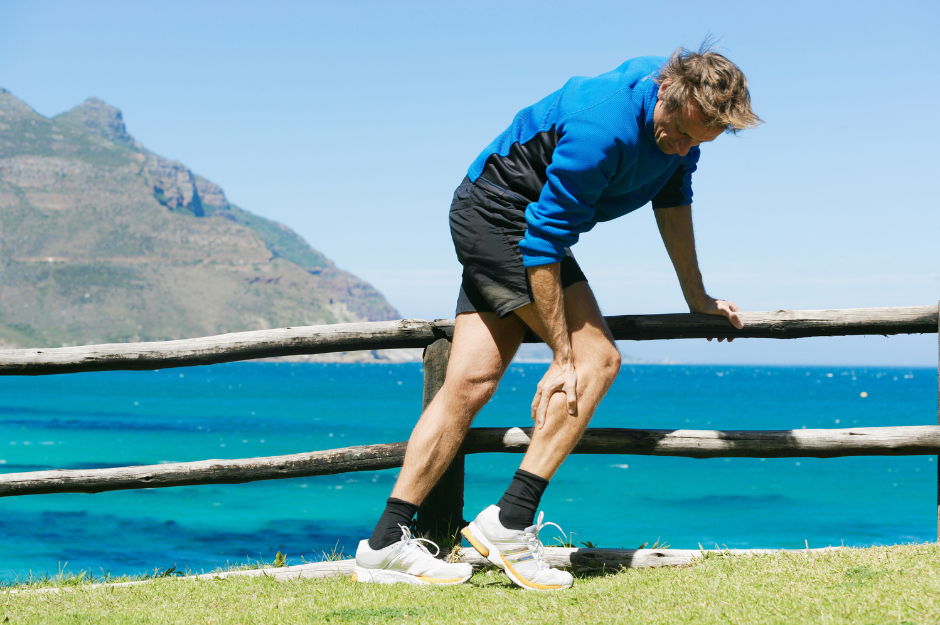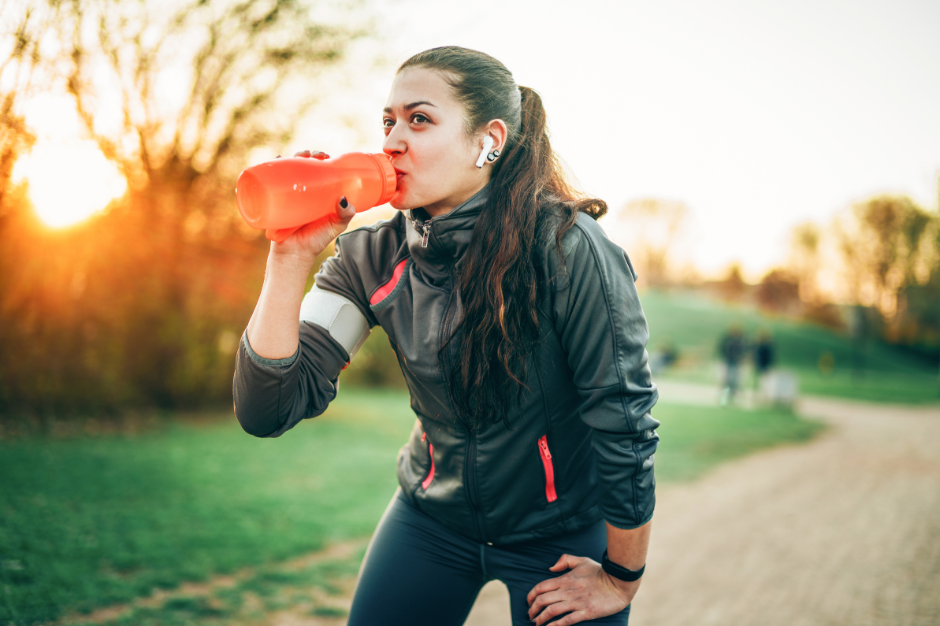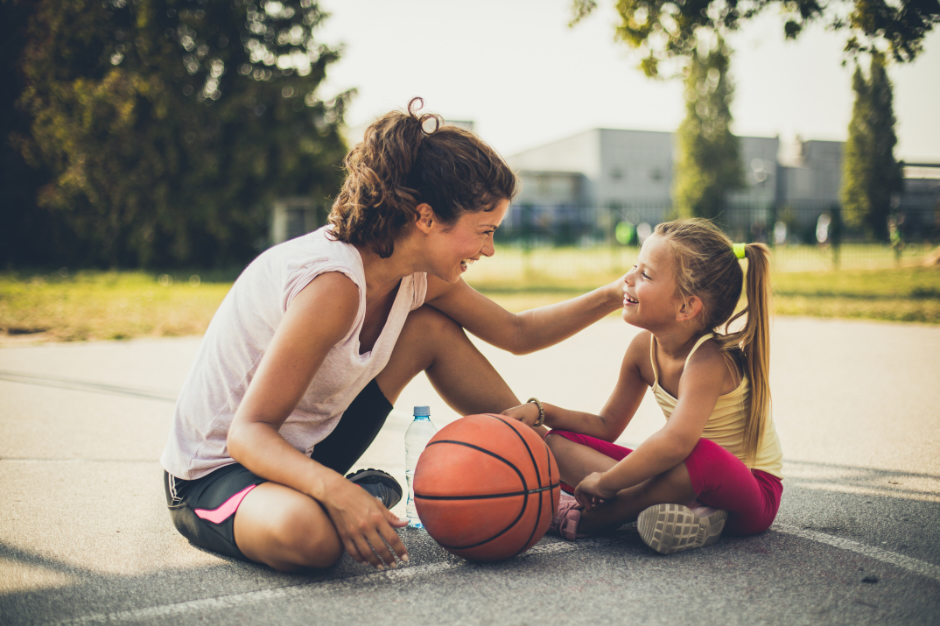

Can You Train for Hot Environments?
Many endurance athletes have to race in the heat. Performing heat acclimation training before an event that takes place in a hot environment can improve your performance.
March 27, 2024

Chris Minson, PhD
Chris Minson is the Kenneth and Kenda Singer Professor in Human Physiology at the University of Oregon. He is the director of the Human Cardiovascular Control Lab. Dr. Minson is an academic expert in exercise physiology, women’s health, heart health and thermoregulation.

Malia Pivec
Malia Pivec began her collegiate career at Boise State and switched to the University of Oregon’s cross country team. At Boise, she competed in the steeplechase outdoors, as well as a couple of 1500s, 5Ks, and 3Ks indoors. She has now joined a local running club for Nike employees called BTC Elite.
Heat training can be dangerous if not done properly
Supervision by an exercise physiologist or coach well-versed in heat training is strongly recommended. Too often people try to do too much too quickly. Overheating or dehydration can occur during heat training and lead to severe consequences. Pregnant women or individuals with certain medical concerns should consult a physician before considering heat training.
Step into what appears to be an ordinary walk-in freezer, and you’ll find yourself in a chamber of extremes. Imagine a space where you can shiver in 0°F temperatures, bask in the scorching heat of a desert day, or experience the thin air of a mountain peak at 22,000 feet. This unassuming room has the power to recreate challenging environmental conditions for athletes.
The chamber is a playground of temperature, humidity, and atmospheric manipulation for Dr. Chris Minson, who works with endurance athletes like cyclists and runners to prepare them for races in hot environments. Heat acclimation training could provide these high-level athletes with small-to-moderate performance gains (e.g., in race time) when competing in high temperatures.
What is Heat Acclimation?
Heat acclimation is when the body gradually becomes more resilient to hot environments using artificial means (e.g., a heat chamber). Acclimation differs from acclimatization, which is when physiological adaptations occur due to repeated exposure in a natural hot environment. Without heat acclimation or acclimatization, exercise in hot environments can lead to added thermal and cardiovascular strain due to rising core body and skin temperatures. This, in turn, can result in decreased performance and, in severe cases, dangerous health consequences.

Adobe Free Photos
Who Benefits from Heat Training?
Dr. Minson cautions that heat training is not for everyone. “Make sure you’ve got your fundamentals down like diet, sleep, recovery, and a training program,” said Dr. Minson.
High-level athletes are likely to reap the benefits of heat training sooner than untrained athletes. This is because untrained individuals might find it challenging to maintain elevated exercise intensities.1
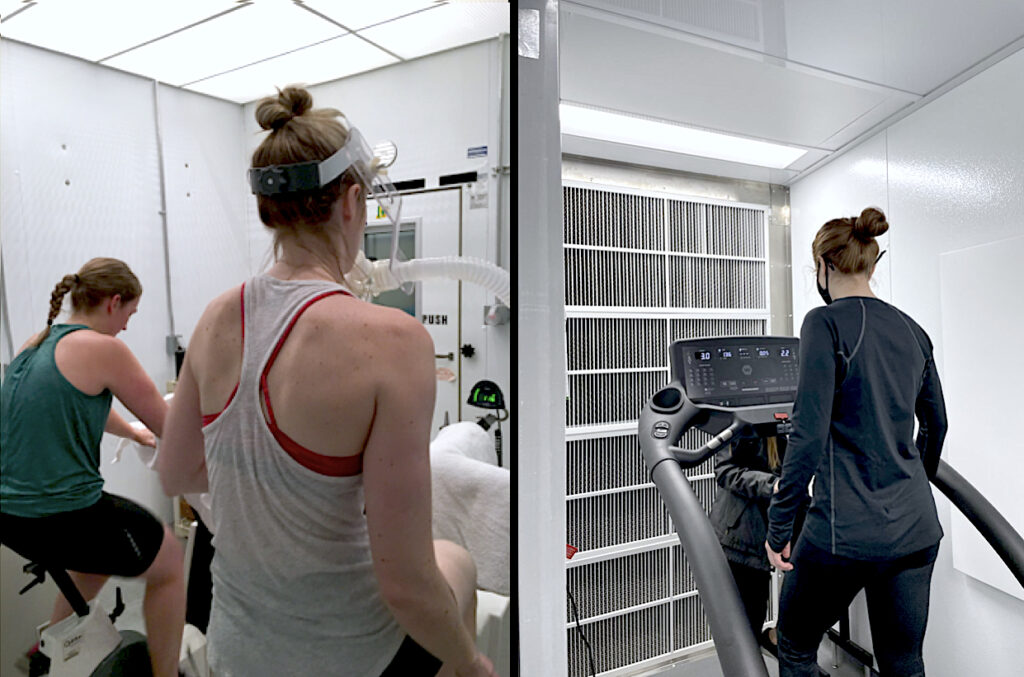
Athletes in Dr. Minson’s heat chamber undergoing performance testing. Image credit: Dusty Whitaker
What Improvements Can Athletes Potentially See?
Beyond changes in heat regulation, such as earlier sweat onset, athletes who incorporate heat training experience other physiological adaptations such as greater blood volume, reduced heart rate, improved maximal oxygen uptake, and increased anaerobic threshold.1,2,3,4
A meta-analysis of 96 studies of heat training demonstrated that the total amount of exercise that can be done in a hot environment can increase by about 23%, while “performance” metrics based on 52 datasets (which combines a variety of outcomes such as the time to complete a 10K run or a 40km cycling time trial) improves about 7%.5 The exact process by which all this happens has not been fully mapped out yet, but researchers have found that after heat acclimation, the activation of physiologic processes like sweating and blood vessel widening now happens at a lower core temperature, meaning that the body starts cooling itself earlier and more effectively in response to increased heat. This results in an overall lower body temperature and heart rate while exercising in the same environment after heat acclimation.

What percentage of participants across all the studies analyzed in the meta-analysis above were female?
Only 76 (7%) participants across all studies in the meta-analysis were female. The limited representation of female participants highlights a significant gap in research concerning female athletes.
Additionally, heat shock proteins play a role. When exposed to repetitive heat, as in heat acclimation, all cells in the body experience a degree of stress due to increased core body temperature. This stress triggers the production of heat shock proteins, which act as a form of cellular protection against immediate damage caused by heat stress. They also help cells develop tolerance against potential heat stress in the future. For example, cells that were previously “exposed to non-lethal heat shock can survive a subsequent otherwise lethal heat shock.”1 This all demonstrates that our body is better protected from potentially damaging heat stress after becoming heat acclimated.
Dr. Minson’s Advice on How to Incorporate Heat Training
There are many different approaches to heat acclimation. Dr. Minson recommends starting under supervision with 20- to 30-minute sessions at around 95°F and gradually building up to 60-minute sessions at 104°F.6 He also recommends repetitive sessions – at least 10-14 days cumulatively in the heat – to achieve full performance benefits in the same environmental conditions.6,7 As heat loss mechanisms like sweating and skin temperature become more efficient, increase exercise intensity to continue to stress the system. Ideally, these heat-training sessions are done in a controlled environment where the athlete can be safely monitored.

Training Tip
Give yourself time to adapt to the heat. At minimum, give yourself 14 days in the heat to achieve full performance benefits.
Timing matters too. “It’s important to separate your heat acclimation strategies from your key training days,” said Dr. Minson. For example, if you perform your hard training days on Tuesdays and Fridays, don’t do your heat training on those days. Why?
“If you’re doing those hard intense days in the heat, you’re doing them slower. You’re more fatigued. It’s another stress,” said Dr. Minson. “Do your key workouts in ideal conditions to maximize your performance on that day. After a good rest and sleep, you can add heat as long as it doesn’t disrupt your recovery. Try to get the benefits from both heat acclimation and intense training but not have them interfere with each other.”
How Quickly Does the Body Adapt During Heat Training?
Different physiological adaptations occur at varying rates. Cardiovascular improvements can be seen in just 4-5 days for well-trained athletes, while changes like increased sweat rate may require up to 14 days. Dr. Minson estimates that 75-80% of the acclimation process happens within the first 4-7 days.1,8,9
The benefits of heat acclimation are not permanent. Any gains you have made will gradually decline if not maintained. This rate of decline follows a similar trend as the gains, meaning the responses that were first to adapt, like improved heart rate, will also be the first to decay. Rate of decay is difficult to study and more research is needed to determine how quickly the decay occurs.

Is temperature at the competition site a factor in heat training effectiveness?
How much time does someone need to engage in heat acclimation if the competition site is 5 versus 15 degrees warmer than their current training location? There’s still debate about that. Currently, there isn’t enough data to develop precise acclimation protocols tailored to specific environmental conditions.
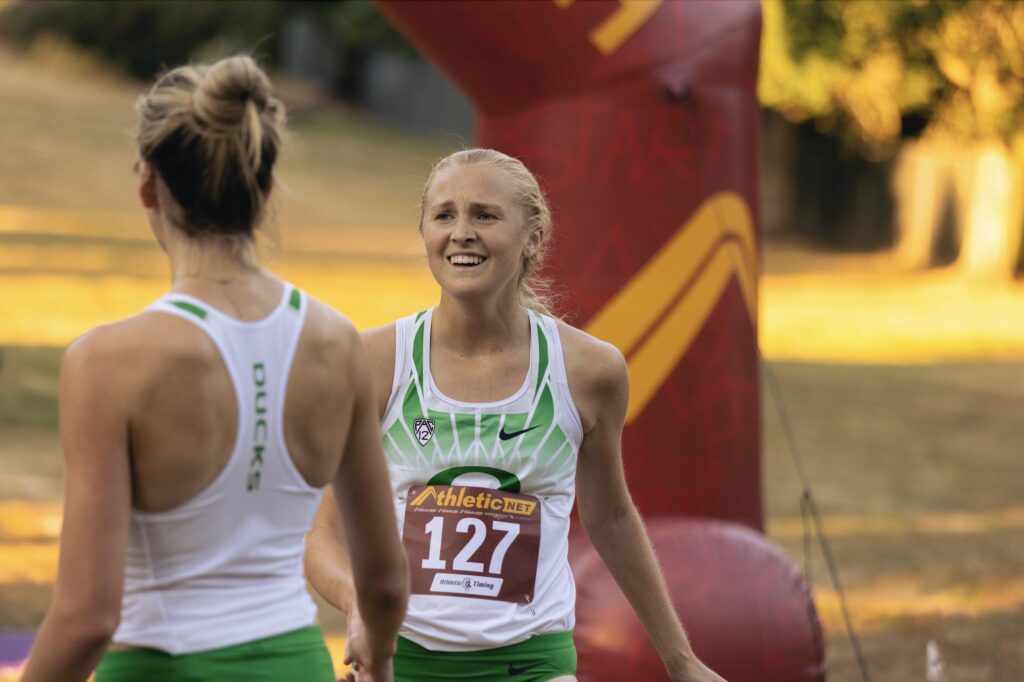
Image provided by Malia Pivec
If athletes cannot undergo heat acclimation in the two weeks leading up to a competition, they can also plan their heat training one month earlier, according to a 2023 International Olympic Committee consensus statement. They can then reintroduce heat acclimation a few days before the event to minimize the decay of adaptation, incorporating biweekly heat exposures in the interim.
Curious to learn more? Stay tuned for future stories on heat training.

Training Tip from the International Olympic Committee
To get used to competing in the heat, it’s best to train in a similar hot environment. If that’s not possible, you can try other methods like “overdressed training” by adding extra clothes or passive heat exposure like a hot tub.
Get Deeply Researched Insights on Human Performance
Join our mailing list to get actionable performance tips and nuanced explanations of the science.

Flash Q&A with Malia Pivec
Did you use Dr. Minson’s heat chamber?
Yes, it was my hot box. I would say it was heaven. My team would probably use another word. As soon as I walked in, it was similar to a sauna.
Can you describe how you incorporated heat training into your regime to prepare for a race?
I began heat training two months prior to the race, 2-3 times a week in the chamber. The athletes who were freshman did passive heat training in hot tubs to ease themselves into it, while the higher volume juniors and seniors were in the heat chamber. Chris would sit down with us and be really intentional with how he planned out our season, where our races were, and what races we wanted to peak. He made sure our frequency would taper off right before our biggest races.
Do you think heat acclimation made a difference to your physical performance?
My perspective is that my body was able to regulate temperature a lot easier. On days where it was maybe 85 degrees Fahrenheit outside, my perception of the temperature was that it’s probably only 70 degrees.
How did your race go?
My Arkansas experience was incredible. Like when it was 80% humidity, 85 degrees, I was like, ‘Malia, you’ve been blessed today.’ The temperature wasn’t overbearing because we had done heat training. I finished fourth in my heat and then qualified for nationals, even though I wasn’t expected to.

Flash Q&A with Dr. Chris Minson
Do you play sports?
I mountain bike the most. I like to do both cross-country and enduro-downhill type of riding. I’m absolutely passionate about mountain biking, but I also love surfing, mountaineering, and rock climbing. I’ve done adventures where we combine pack rafting, mountain biking, and skiing.
Can you chat more about one of those adventures?
My friend and I did a circumnavigation of Mount Rainier called the High Orbit route. It’s the most glaciated peak in the United States outside of Alaska. The goal wasn’t to summit but traverse between 8,000 and 11,000 feet. We crossed 22 glaciers and slept on the glaciers. That took every skill we had as far as mountaineering. We were on skis a lot, there was crevasse travel, ice climbing. Everything in that one was quite the adventure and challenging.
Citations
- Pryor, J.L., Minson, C.T., Ferrara, M.S. (2018). Heat acclimation. Sport and Physical Activity in the Heat. 33–58. https://doi.org/10.1007/978-3-319-70217-9_3
- Lorenzo S., Minson C. T. Heat acclimation improves cutaneous vascular function and sweating in trained cyclists. (2010). Journal of Applied Physiology. 109(6):1736–1743. https://doi.org/10.1152/japplphysiol.00725.2010.
- Waldron M., Fowler R., Heffernan S., et al. (2021) Effects of heat acclimation and acclimatisation on maximal aerobic capacity compared to exercise alone in both thermoneutral and hot environments: a meta-analysis and meta-regression. Sports Medicine. 51(7):1509-1525. https://doi.org/10.1007/s40279-021-01445-6.

How reliable are meta-analyses on heat training?
There are few meta-analyses on heat training and those that do exist often pool data from studies that have used different outcome measures (e.g., X vs Y), types and intensities of exercise, and heat acclimation protocols. These are just a few differences, so you can imagine the challenge in drawing conclusions from such disparate experiments. Even though meta-analyses are often considered “top tier” research quality metrics, take a closer look at the studies that are included to decide how strongly you can rely on the conclusions. Only a handful of studies? Studies measure different outcomes or focus on different sports? The meta-analysis results will be weaker.
- Périard J. D., Travers G. J. S., Racinais S., et al. (2016) Cardiovascular adaptations supporting human exercise-heat acclimation. Autonomic Neuroscience. 196: 52-62. https://doi.org/10.1016/j.autneu.2016.02.002.
- Tyler, C.J., Reeve, T., Hodges, G.J. et al. (2016) The effects of heat adaptation on physiology, perception and exercise performance in the heat: a meta-analysis. Sports Medicine. 46: 1699–1724. https://doi.org/10.1007/s40279-016-0538-5
- Gibson O.R., James C.A., Mee J.A., et al. (2019) Heat alleviation strategies for athletic performance: a review and practitioner guidelines. Temperature. 7(1):3-36. https://doi.org/10.1080/23328940.2019.1666624.
- Racinais S., Hosokawa Y., Akama T., et al. (2023) IOC consensus statement on recommendations and regulations for sport events in the heat. British Journal of Sports Medicine. 57(1):8-25. https://doi.org/10.1136/bjsports-2022-105942.
- Périard, J.D., Racinais S., and Sawka, M.N. (2015) Adaptations and mechanisms of human heat acclimation: Applications for competitive athletes and sports. Scandinavian Journal of Medicine and Science in Sports. 25(S1): 20–38. https://doi.org/10.1111/sms.12408.
- Pandolf, K.B. (1998) Time course of heat acclimation and its decay. International Journal of Sports Medicine. 19:S157-60. https://doi.org/10.1055/s-2007-971985.
- Daanen H.A.M., Racinais S., Périard J.D. (2018) Heat acclimation decay and re-induction: a systematic review and meta-analysis. Sports Medicine. 48(2):409-430. https://doi.org/10.1007/s40279-017-0808-x.
Playbook Terms of Use & Copyright
©2023-2024

